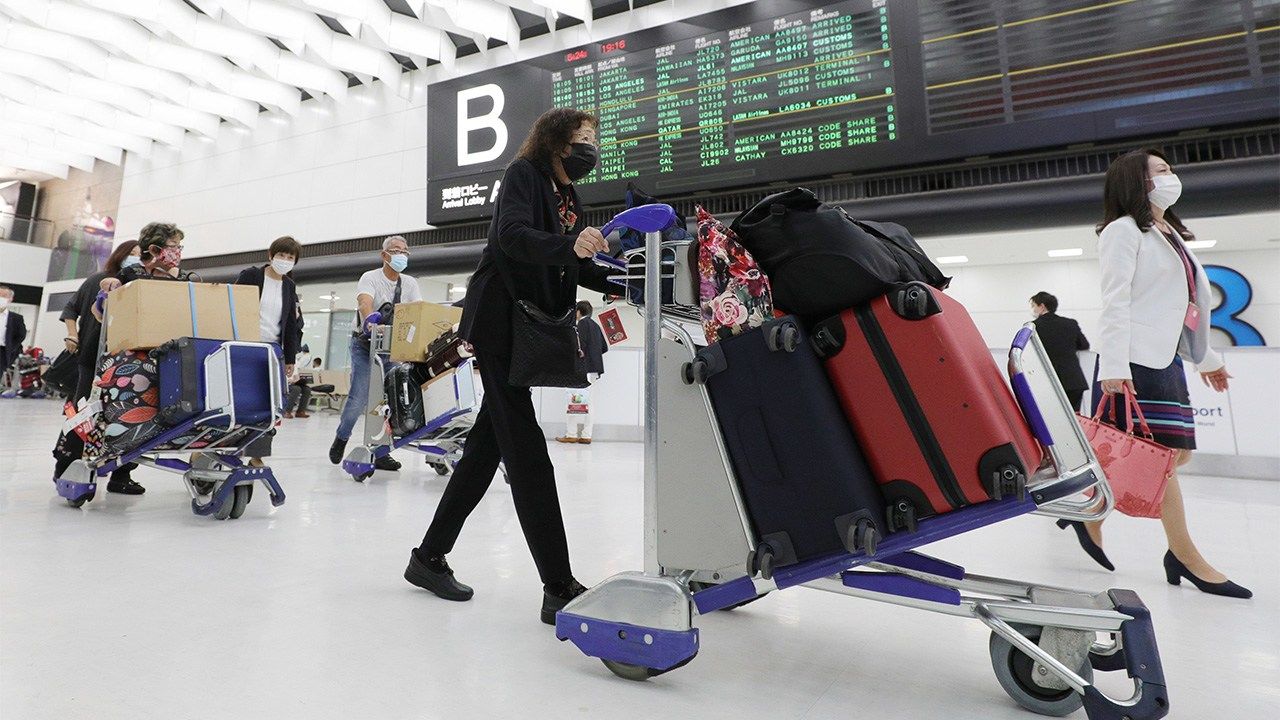
Japan to Ease Entry Restrictions from June
Society Economy World- English
- 日本語
- 简体字
- 繁體字
- Français
- Español
- العربية
- Русский
In January 2021, the Japanese government started airport testing of all entrants, including Japanese citizens, for COVID-19. On June 1, 2022, the government will introduce a new system dividing countries or regions into three groups classified by risk. Travelers in the low-risk blue group will not have to take tests or self-quarantine upon arrival. Those in the medium-risk yellow group are also not required to pass through these formalities if they have received three vaccination doses. However, for those in the high-risk red group, testing after landing and three days of self-quarantine will continue to be mandatory. The daily entry cap will also be raised from 10,000 to 20,000.
All groups will have to be tested before boarding flights to Japan. Countries and regions are categorized based on their positivity rates, with around 80% of entrants falling in the low-risk group.
Requirement for Testing on Arrival from June 1
| Group | 3 Vaccinations | 0–2 Vaccinations |
|---|---|---|
| Low-Risk (Blue) | Not Required | Not Required |
| Medium-Risk (Yellow) | Not Required | Required |
| High-Risk (Red) | Required | Required |
From May 24, the Japan Tourism Agency and private travel companies have started experimentally bringing foreign tour groups into the country. Around 50 tourists from the United States, Australia, Singapore, and Thailand will travel around the country until early June, providing the opportunity to identify any issues before a full-scale reopening of the country to tourism.
Categorization of Countries/Regions from June 1
| Group | Countries/Regions |
|---|---|
| Low-Risk (Blue) | Afghanistan, Algeria, Argentina, Armenia, Australia, Austria, Azerbaijan, Bahrain, Bangladesh, Belgium, Benin, Bolivia, Bosnia and Herzegovina, Brazil, Britain, Bulgaria, Cambodia, Cameroon, Canada, Chile, China, Colombia, Costa Rica, Cote d’lvoire, Croatia, Czech Republic, Denmark, Djibouti, Dominican Republic, Ecuador, El Salvador, Estonia, Ethiopia, Finland, France, Germany, Ghana, Greece, Guatemala, Hong Kong, Hungary, Iceland, Indonesia, Iran, Iraq, Ireland, Israel, Italy, Jamaica, Jordan, Kenya, Kyrgyzstan, Laos, Latvia, Lithuania, Luxembourg, Madagascar, Malawi, Malaysia, Mexico, Monaco, Mongolia, Montenegro, Morocco, Mozambique, Myanmar, Netherlands, New Zealand, Nigeria, Norway, Palau, Panama, Papua New Guinea, Paraguay, Philippines, Poland, Qatar, Republic of Korea, Romania, Russia, Rwanda, Serbia, Singapore, Slovakia, Slovenia, South Africa, South Sudan, Spain, Sweden, Switzerland, Taiwan, Tanzania, Thailand, Timor-Leste, Uganda, United Arab Emirates, United States of America, Zambia |
| Medium-Risk (Yellow) | Andorra, Angola, Antigua and Barbuda, Bahamas, Barbados, Belarus, Belize, Bhutan, Botswana, Brunei, Burkina Faso, Burundi, Cape Verde, Central African Republic, Chad, Comoros, Cook Island, Cuba, Cyprus, Democratic Republic of the Congo, Dominica, Egypt, Equatorial Guinea, Eritrea, Eswatini, Federated States of Micronesia, Gabon, Gambia, Georgia, Grenada, Guinea, Guinea-Bissau, Guyana, Haiti, Honduras, India, Kazakhstan, Kiribati, Kosovo, Kuwait, Lebanon, Lesotho, Liberia, Libya, Liechtenstein, Macau, Maldives, Mali, Malta, Marshall Islands, Mauritania, Mauritius, Moldova, Namibia, Nauru, Nepal, Nicaragua, Niger, Niue, North Korea, North Macedonia, Oman, Palestine, Peru, Portugal, Republic of the Congo, Saint Christopher and Nevis, Saint Lucia, Saint Vincent and the Grenadines, Samoa, San Marino, Sao Tome and Principe, Saudi Arabia, Senegal, Seychelles, Solomon, Somalia, Sri Lanka, Sudan, Suriname, Syria, Tajikistan, Togo, Tonga, Trinidad and Tobago, Tunisia, Turkey, Turkmenistan, Tuvalu, Ukraine, Uruguay, Uzbekistan, Vatican City, Vanuatu, Venezuela, Vietnam, Western Sahara, Yemen, Zimbabwe |
| High-Risk (Red) | Albania, Fiji, Pakistan, Sierra Leone |
(Originally published in Japanese. Banner photo: A group of American tourists arrives in Japan on May 24, 2022. © Jiji.)